Mechanical Designs for Reducing the Carbon Footprint: Analysis
VerifiedAdded on 2023/01/11
|7
|1723
|87
Annotated Bibliography
AI Summary
This annotated bibliography examines various research papers focused on mechanical designs aimed at reducing carbon footprints. The studies cover diverse approaches, including the use of sustainable materials, lightweight designs, and the application of thermodynamic principles to optimize machine efficiency. Several papers propose integrated product models and the modification of geometric designs to lower carbon emissions. The research also explores cost-effective solutions, such as the use of renewable energy sources and the application of mathematical models to determine carbon emission percentages. Furthermore, the bibliography includes studies on energy management in manufacturing, smart manufacturing systems, and the integration of new materials like geo-polymers to enhance sustainability. The findings highlight the importance of balancing mass and balance calculations, optimizing structural designs, and considering life cycle assessments to mitigate the environmental impact of mechanical systems. Overall, the bibliography provides a comprehensive overview of current research and potential strategies for achieving sustainable development in mechanical engineering.
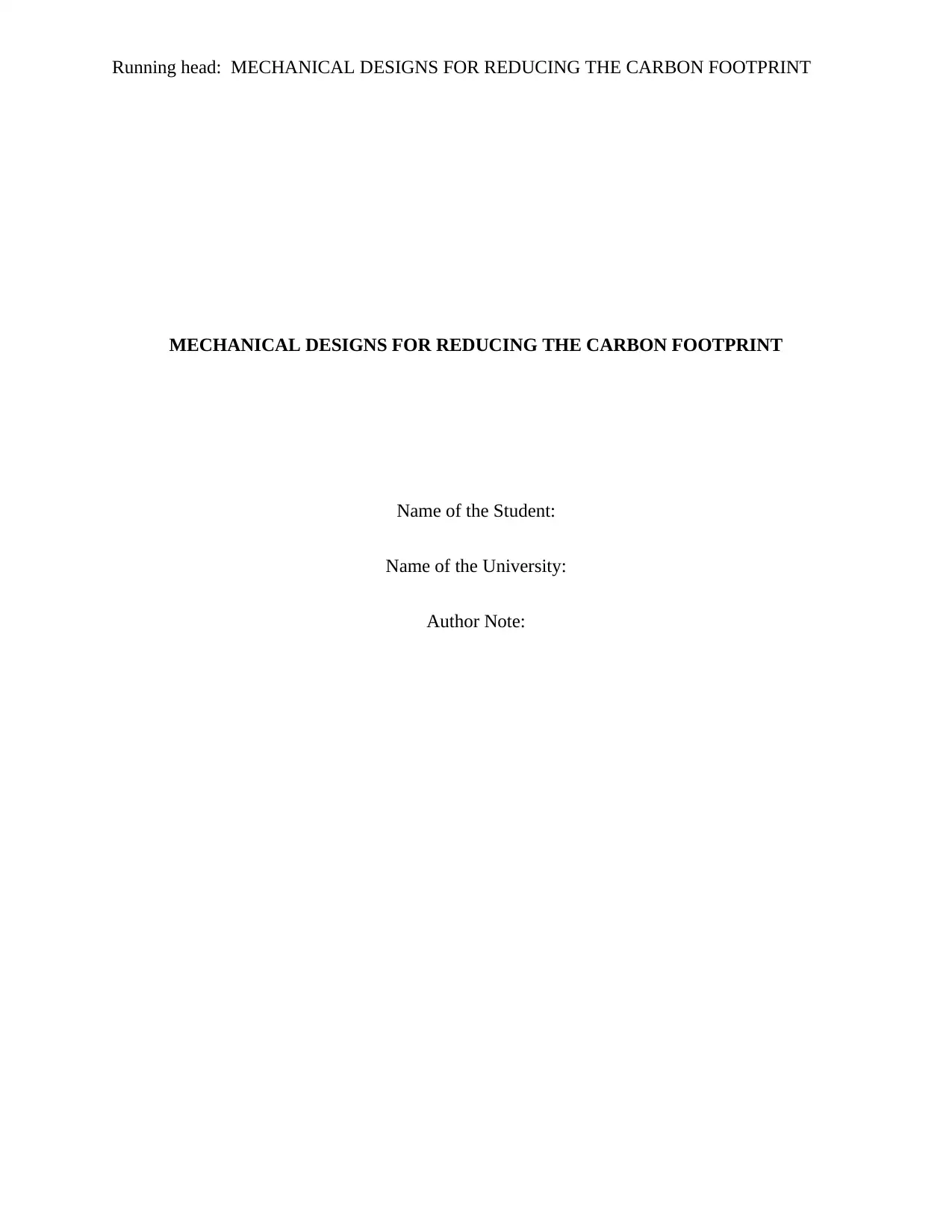
Running head: MECHANICAL DESIGNS FOR REDUCING THE CARBON FOOTPRINT
MECHANICAL DESIGNS FOR REDUCING THE CARBON FOOTPRINT
Name of the Student:
Name of the University:
Author Note:
MECHANICAL DESIGNS FOR REDUCING THE CARBON FOOTPRINT
Name of the Student:
Name of the University:
Author Note:
Paraphrase This Document
Need a fresh take? Get an instant paraphrase of this document with our AI Paraphraser
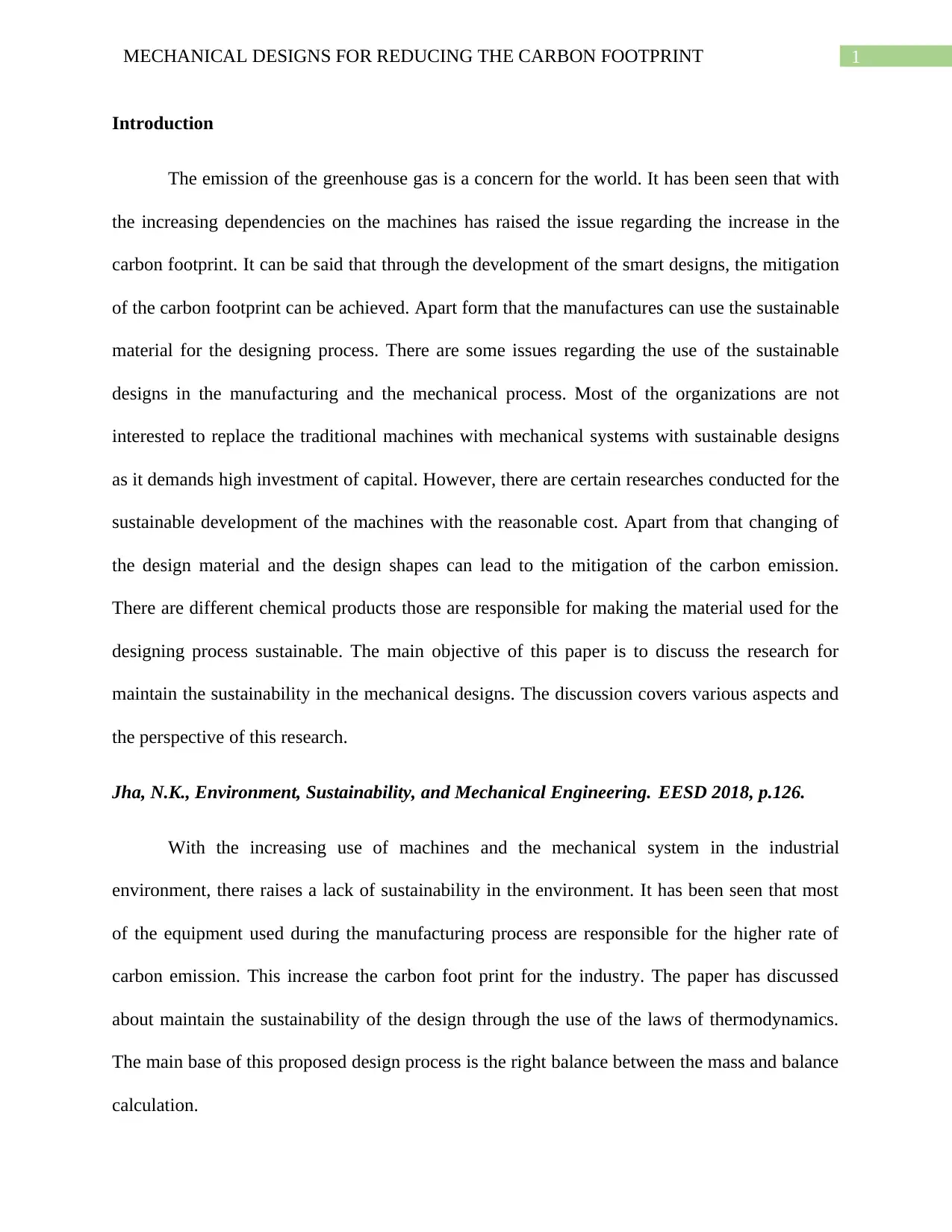
1MECHANICAL DESIGNS FOR REDUCING THE CARBON FOOTPRINT
Introduction
The emission of the greenhouse gas is a concern for the world. It has been seen that with
the increasing dependencies on the machines has raised the issue regarding the increase in the
carbon footprint. It can be said that through the development of the smart designs, the mitigation
of the carbon footprint can be achieved. Apart form that the manufactures can use the sustainable
material for the designing process. There are some issues regarding the use of the sustainable
designs in the manufacturing and the mechanical process. Most of the organizations are not
interested to replace the traditional machines with mechanical systems with sustainable designs
as it demands high investment of capital. However, there are certain researches conducted for the
sustainable development of the machines with the reasonable cost. Apart from that changing of
the design material and the design shapes can lead to the mitigation of the carbon emission.
There are different chemical products those are responsible for making the material used for the
designing process sustainable. The main objective of this paper is to discuss the research for
maintain the sustainability in the mechanical designs. The discussion covers various aspects and
the perspective of this research.
Jha, N.K., Environment, Sustainability, and Mechanical Engineering. EESD 2018, p.126.
With the increasing use of machines and the mechanical system in the industrial
environment, there raises a lack of sustainability in the environment. It has been seen that most
of the equipment used during the manufacturing process are responsible for the higher rate of
carbon emission. This increase the carbon foot print for the industry. The paper has discussed
about maintain the sustainability of the design through the use of the laws of thermodynamics.
The main base of this proposed design process is the right balance between the mass and balance
calculation.
Introduction
The emission of the greenhouse gas is a concern for the world. It has been seen that with
the increasing dependencies on the machines has raised the issue regarding the increase in the
carbon footprint. It can be said that through the development of the smart designs, the mitigation
of the carbon footprint can be achieved. Apart form that the manufactures can use the sustainable
material for the designing process. There are some issues regarding the use of the sustainable
designs in the manufacturing and the mechanical process. Most of the organizations are not
interested to replace the traditional machines with mechanical systems with sustainable designs
as it demands high investment of capital. However, there are certain researches conducted for the
sustainable development of the machines with the reasonable cost. Apart from that changing of
the design material and the design shapes can lead to the mitigation of the carbon emission.
There are different chemical products those are responsible for making the material used for the
designing process sustainable. The main objective of this paper is to discuss the research for
maintain the sustainability in the mechanical designs. The discussion covers various aspects and
the perspective of this research.
Jha, N.K., Environment, Sustainability, and Mechanical Engineering. EESD 2018, p.126.
With the increasing use of machines and the mechanical system in the industrial
environment, there raises a lack of sustainability in the environment. It has been seen that most
of the equipment used during the manufacturing process are responsible for the higher rate of
carbon emission. This increase the carbon foot print for the industry. The paper has discussed
about maintain the sustainability of the design through the use of the laws of thermodynamics.
The main base of this proposed design process is the right balance between the mass and balance
calculation.
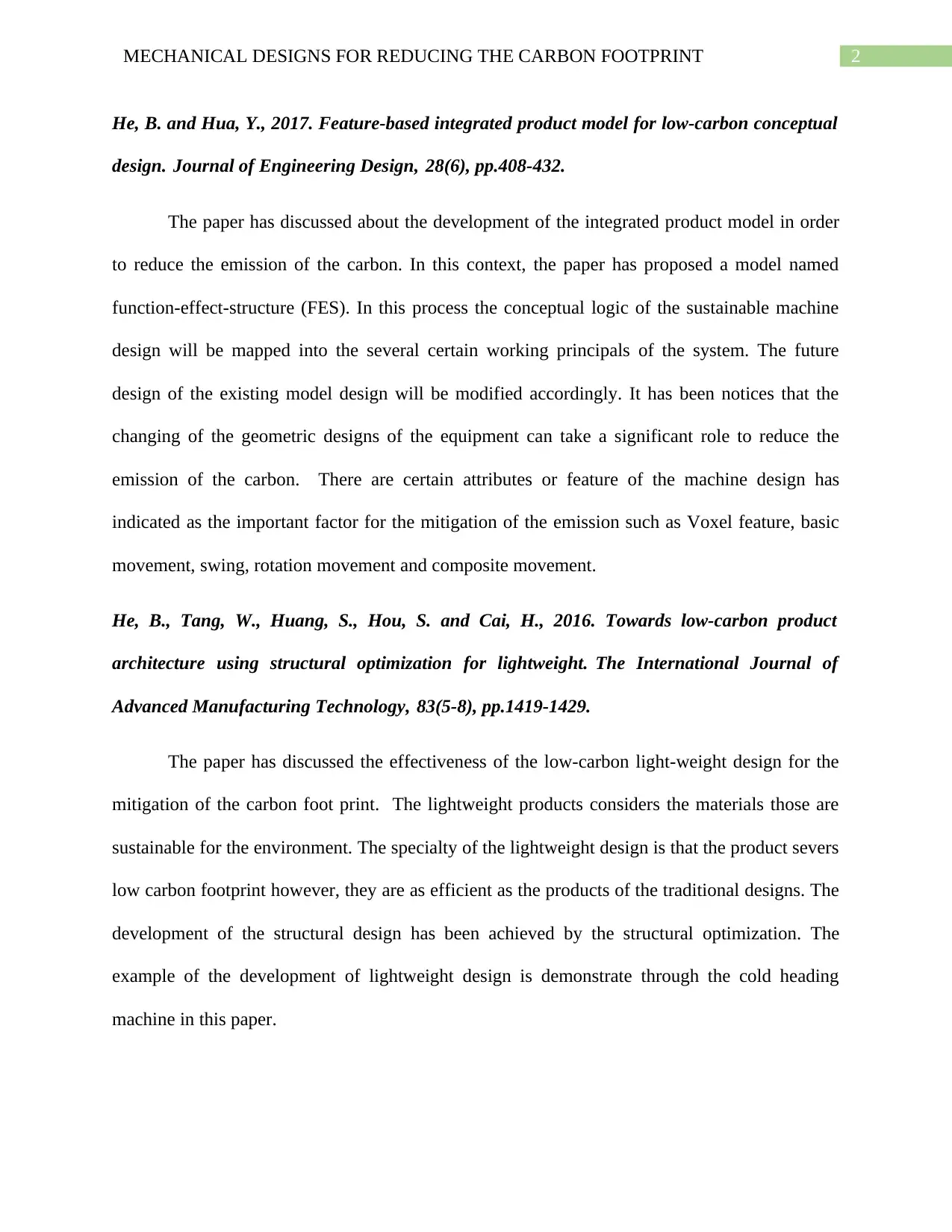
2MECHANICAL DESIGNS FOR REDUCING THE CARBON FOOTPRINT
He, B. and Hua, Y., 2017. Feature-based integrated product model for low-carbon conceptual
design. Journal of Engineering Design, 28(6), pp.408-432.
The paper has discussed about the development of the integrated product model in order
to reduce the emission of the carbon. In this context, the paper has proposed a model named
function-effect-structure (FES). In this process the conceptual logic of the sustainable machine
design will be mapped into the several certain working principals of the system. The future
design of the existing model design will be modified accordingly. It has been notices that the
changing of the geometric designs of the equipment can take a significant role to reduce the
emission of the carbon. There are certain attributes or feature of the machine design has
indicated as the important factor for the mitigation of the emission such as Voxel feature, basic
movement, swing, rotation movement and composite movement.
He, B., Tang, W., Huang, S., Hou, S. and Cai, H., 2016. Towards low-carbon product
architecture using structural optimization for lightweight. The International Journal of
Advanced Manufacturing Technology, 83(5-8), pp.1419-1429.
The paper has discussed the effectiveness of the low-carbon light-weight design for the
mitigation of the carbon foot print. The lightweight products considers the materials those are
sustainable for the environment. The specialty of the lightweight design is that the product severs
low carbon footprint however, they are as efficient as the products of the traditional designs. The
development of the structural design has been achieved by the structural optimization. The
example of the development of lightweight design is demonstrate through the cold heading
machine in this paper.
He, B. and Hua, Y., 2017. Feature-based integrated product model for low-carbon conceptual
design. Journal of Engineering Design, 28(6), pp.408-432.
The paper has discussed about the development of the integrated product model in order
to reduce the emission of the carbon. In this context, the paper has proposed a model named
function-effect-structure (FES). In this process the conceptual logic of the sustainable machine
design will be mapped into the several certain working principals of the system. The future
design of the existing model design will be modified accordingly. It has been notices that the
changing of the geometric designs of the equipment can take a significant role to reduce the
emission of the carbon. There are certain attributes or feature of the machine design has
indicated as the important factor for the mitigation of the emission such as Voxel feature, basic
movement, swing, rotation movement and composite movement.
He, B., Tang, W., Huang, S., Hou, S. and Cai, H., 2016. Towards low-carbon product
architecture using structural optimization for lightweight. The International Journal of
Advanced Manufacturing Technology, 83(5-8), pp.1419-1429.
The paper has discussed the effectiveness of the low-carbon light-weight design for the
mitigation of the carbon foot print. The lightweight products considers the materials those are
sustainable for the environment. The specialty of the lightweight design is that the product severs
low carbon footprint however, they are as efficient as the products of the traditional designs. The
development of the structural design has been achieved by the structural optimization. The
example of the development of lightweight design is demonstrate through the cold heading
machine in this paper.
⊘ This is a preview!⊘
Do you want full access?
Subscribe today to unlock all pages.

Trusted by 1+ million students worldwide
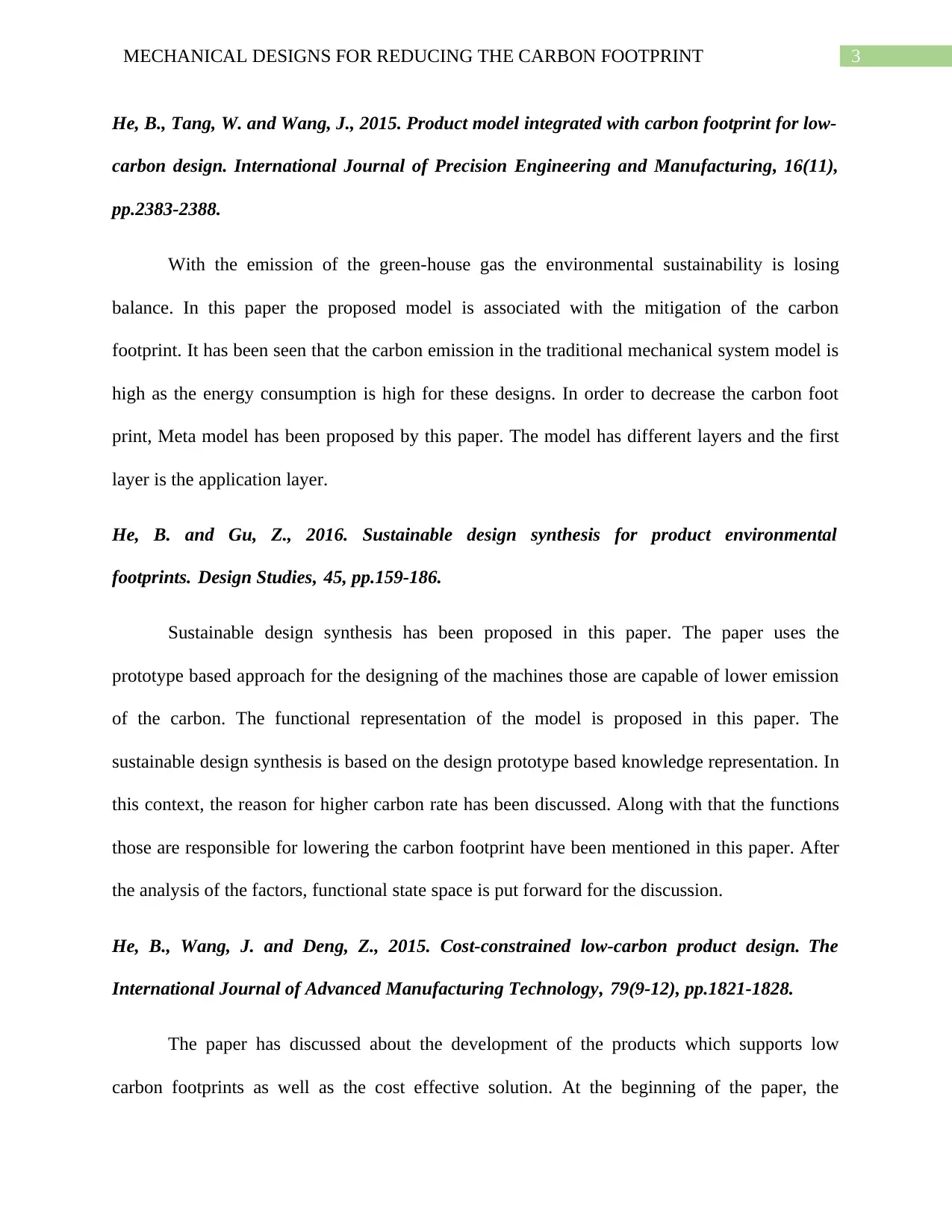
3MECHANICAL DESIGNS FOR REDUCING THE CARBON FOOTPRINT
He, B., Tang, W. and Wang, J., 2015. Product model integrated with carbon footprint for low-
carbon design. International Journal of Precision Engineering and Manufacturing, 16(11),
pp.2383-2388.
With the emission of the green-house gas the environmental sustainability is losing
balance. In this paper the proposed model is associated with the mitigation of the carbon
footprint. It has been seen that the carbon emission in the traditional mechanical system model is
high as the energy consumption is high for these designs. In order to decrease the carbon foot
print, Meta model has been proposed by this paper. The model has different layers and the first
layer is the application layer.
He, B. and Gu, Z., 2016. Sustainable design synthesis for product environmental
footprints. Design Studies, 45, pp.159-186.
Sustainable design synthesis has been proposed in this paper. The paper uses the
prototype based approach for the designing of the machines those are capable of lower emission
of the carbon. The functional representation of the model is proposed in this paper. The
sustainable design synthesis is based on the design prototype based knowledge representation. In
this context, the reason for higher carbon rate has been discussed. Along with that the functions
those are responsible for lowering the carbon footprint have been mentioned in this paper. After
the analysis of the factors, functional state space is put forward for the discussion.
He, B., Wang, J. and Deng, Z., 2015. Cost-constrained low-carbon product design. The
International Journal of Advanced Manufacturing Technology, 79(9-12), pp.1821-1828.
The paper has discussed about the development of the products which supports low
carbon footprints as well as the cost effective solution. At the beginning of the paper, the
He, B., Tang, W. and Wang, J., 2015. Product model integrated with carbon footprint for low-
carbon design. International Journal of Precision Engineering and Manufacturing, 16(11),
pp.2383-2388.
With the emission of the green-house gas the environmental sustainability is losing
balance. In this paper the proposed model is associated with the mitigation of the carbon
footprint. It has been seen that the carbon emission in the traditional mechanical system model is
high as the energy consumption is high for these designs. In order to decrease the carbon foot
print, Meta model has been proposed by this paper. The model has different layers and the first
layer is the application layer.
He, B. and Gu, Z., 2016. Sustainable design synthesis for product environmental
footprints. Design Studies, 45, pp.159-186.
Sustainable design synthesis has been proposed in this paper. The paper uses the
prototype based approach for the designing of the machines those are capable of lower emission
of the carbon. The functional representation of the model is proposed in this paper. The
sustainable design synthesis is based on the design prototype based knowledge representation. In
this context, the reason for higher carbon rate has been discussed. Along with that the functions
those are responsible for lowering the carbon footprint have been mentioned in this paper. After
the analysis of the factors, functional state space is put forward for the discussion.
He, B., Wang, J. and Deng, Z., 2015. Cost-constrained low-carbon product design. The
International Journal of Advanced Manufacturing Technology, 79(9-12), pp.1821-1828.
The paper has discussed about the development of the products which supports low
carbon footprints as well as the cost effective solution. At the beginning of the paper, the
Paraphrase This Document
Need a fresh take? Get an instant paraphrase of this document with our AI Paraphraser
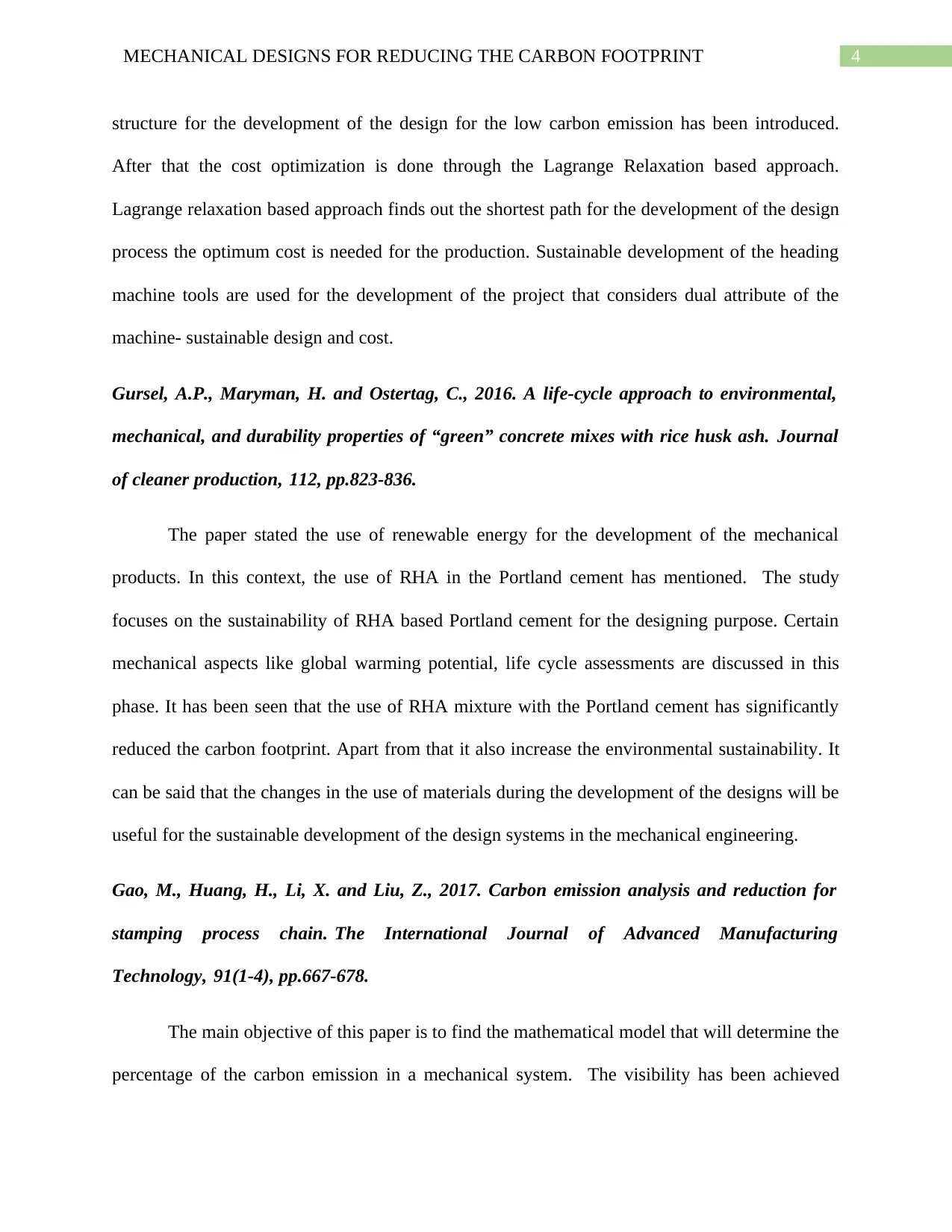
4MECHANICAL DESIGNS FOR REDUCING THE CARBON FOOTPRINT
structure for the development of the design for the low carbon emission has been introduced.
After that the cost optimization is done through the Lagrange Relaxation based approach.
Lagrange relaxation based approach finds out the shortest path for the development of the design
process the optimum cost is needed for the production. Sustainable development of the heading
machine tools are used for the development of the project that considers dual attribute of the
machine- sustainable design and cost.
Gursel, A.P., Maryman, H. and Ostertag, C., 2016. A life-cycle approach to environmental,
mechanical, and durability properties of “green” concrete mixes with rice husk ash. Journal
of cleaner production, 112, pp.823-836.
The paper stated the use of renewable energy for the development of the mechanical
products. In this context, the use of RHA in the Portland cement has mentioned. The study
focuses on the sustainability of RHA based Portland cement for the designing purpose. Certain
mechanical aspects like global warming potential, life cycle assessments are discussed in this
phase. It has been seen that the use of RHA mixture with the Portland cement has significantly
reduced the carbon footprint. Apart from that it also increase the environmental sustainability. It
can be said that the changes in the use of materials during the development of the designs will be
useful for the sustainable development of the design systems in the mechanical engineering.
Gao, M., Huang, H., Li, X. and Liu, Z., 2017. Carbon emission analysis and reduction for
stamping process chain. The International Journal of Advanced Manufacturing
Technology, 91(1-4), pp.667-678.
The main objective of this paper is to find the mathematical model that will determine the
percentage of the carbon emission in a mechanical system. The visibility has been achieved
structure for the development of the design for the low carbon emission has been introduced.
After that the cost optimization is done through the Lagrange Relaxation based approach.
Lagrange relaxation based approach finds out the shortest path for the development of the design
process the optimum cost is needed for the production. Sustainable development of the heading
machine tools are used for the development of the project that considers dual attribute of the
machine- sustainable design and cost.
Gursel, A.P., Maryman, H. and Ostertag, C., 2016. A life-cycle approach to environmental,
mechanical, and durability properties of “green” concrete mixes with rice husk ash. Journal
of cleaner production, 112, pp.823-836.
The paper stated the use of renewable energy for the development of the mechanical
products. In this context, the use of RHA in the Portland cement has mentioned. The study
focuses on the sustainability of RHA based Portland cement for the designing purpose. Certain
mechanical aspects like global warming potential, life cycle assessments are discussed in this
phase. It has been seen that the use of RHA mixture with the Portland cement has significantly
reduced the carbon footprint. Apart from that it also increase the environmental sustainability. It
can be said that the changes in the use of materials during the development of the designs will be
useful for the sustainable development of the design systems in the mechanical engineering.
Gao, M., Huang, H., Li, X. and Liu, Z., 2017. Carbon emission analysis and reduction for
stamping process chain. The International Journal of Advanced Manufacturing
Technology, 91(1-4), pp.667-678.
The main objective of this paper is to find the mathematical model that will determine the
percentage of the carbon emission in a mechanical system. The visibility has been achieved
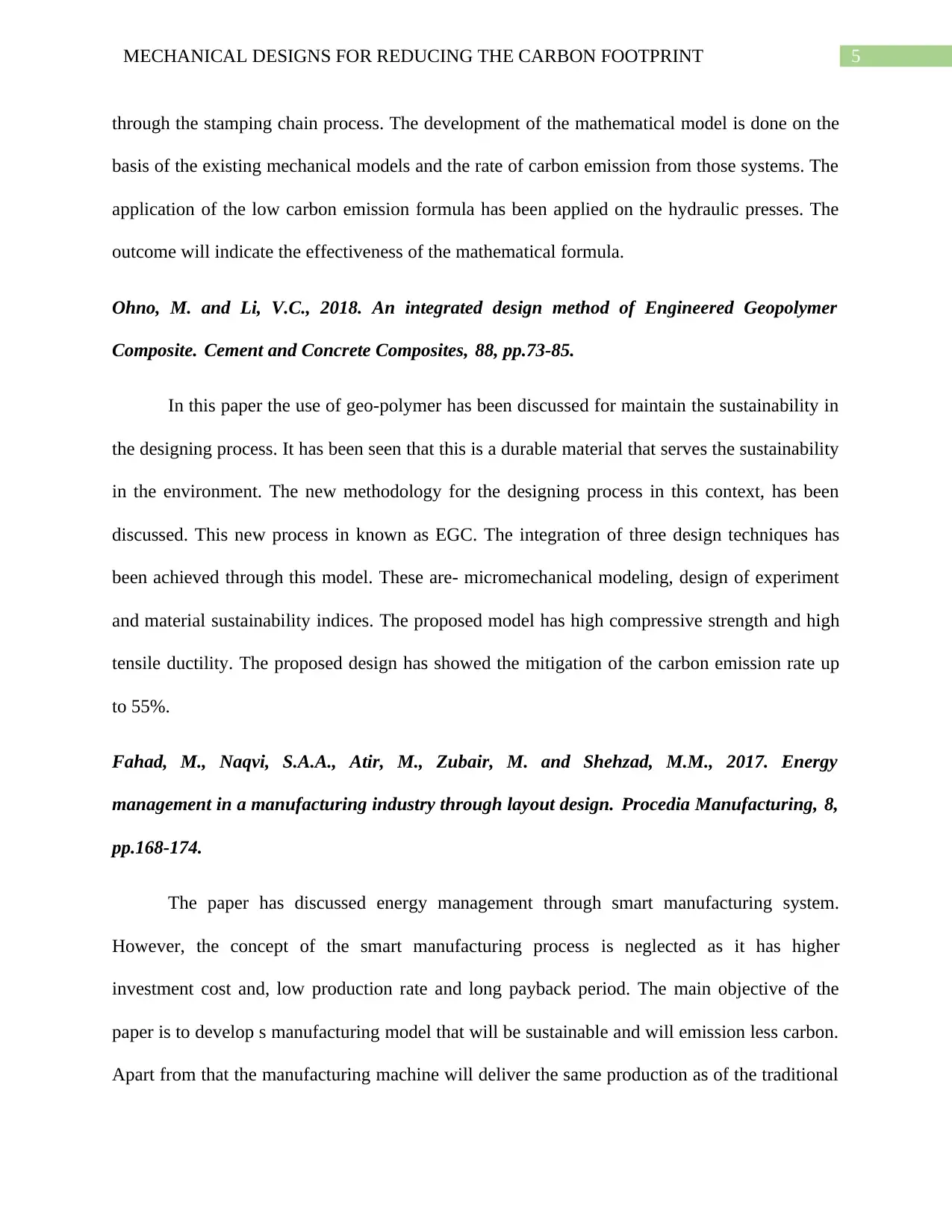
5MECHANICAL DESIGNS FOR REDUCING THE CARBON FOOTPRINT
through the stamping chain process. The development of the mathematical model is done on the
basis of the existing mechanical models and the rate of carbon emission from those systems. The
application of the low carbon emission formula has been applied on the hydraulic presses. The
outcome will indicate the effectiveness of the mathematical formula.
Ohno, M. and Li, V.C., 2018. An integrated design method of Engineered Geopolymer
Composite. Cement and Concrete Composites, 88, pp.73-85.
In this paper the use of geo-polymer has been discussed for maintain the sustainability in
the designing process. It has been seen that this is a durable material that serves the sustainability
in the environment. The new methodology for the designing process in this context, has been
discussed. This new process in known as EGC. The integration of three design techniques has
been achieved through this model. These are- micromechanical modeling, design of experiment
and material sustainability indices. The proposed model has high compressive strength and high
tensile ductility. The proposed design has showed the mitigation of the carbon emission rate up
to 55%.
Fahad, M., Naqvi, S.A.A., Atir, M., Zubair, M. and Shehzad, M.M., 2017. Energy
management in a manufacturing industry through layout design. Procedia Manufacturing, 8,
pp.168-174.
The paper has discussed energy management through smart manufacturing system.
However, the concept of the smart manufacturing process is neglected as it has higher
investment cost and, low production rate and long payback period. The main objective of the
paper is to develop s manufacturing model that will be sustainable and will emission less carbon.
Apart from that the manufacturing machine will deliver the same production as of the traditional
through the stamping chain process. The development of the mathematical model is done on the
basis of the existing mechanical models and the rate of carbon emission from those systems. The
application of the low carbon emission formula has been applied on the hydraulic presses. The
outcome will indicate the effectiveness of the mathematical formula.
Ohno, M. and Li, V.C., 2018. An integrated design method of Engineered Geopolymer
Composite. Cement and Concrete Composites, 88, pp.73-85.
In this paper the use of geo-polymer has been discussed for maintain the sustainability in
the designing process. It has been seen that this is a durable material that serves the sustainability
in the environment. The new methodology for the designing process in this context, has been
discussed. This new process in known as EGC. The integration of three design techniques has
been achieved through this model. These are- micromechanical modeling, design of experiment
and material sustainability indices. The proposed model has high compressive strength and high
tensile ductility. The proposed design has showed the mitigation of the carbon emission rate up
to 55%.
Fahad, M., Naqvi, S.A.A., Atir, M., Zubair, M. and Shehzad, M.M., 2017. Energy
management in a manufacturing industry through layout design. Procedia Manufacturing, 8,
pp.168-174.
The paper has discussed energy management through smart manufacturing system.
However, the concept of the smart manufacturing process is neglected as it has higher
investment cost and, low production rate and long payback period. The main objective of the
paper is to develop s manufacturing model that will be sustainable and will emission less carbon.
Apart from that the manufacturing machine will deliver the same production as of the traditional
⊘ This is a preview!⊘
Do you want full access?
Subscribe today to unlock all pages.

Trusted by 1+ million students worldwide

6MECHANICAL DESIGNS FOR REDUCING THE CARBON FOOTPRINT
machine. Lean tools and systematic layout planning have been employed for the deployment of
this model. The study compares the energy management and the reduction of the waste with the
traditional manufacturing system.
machine. Lean tools and systematic layout planning have been employed for the deployment of
this model. The study compares the energy management and the reduction of the waste with the
traditional manufacturing system.
1 out of 7
Related Documents
Your All-in-One AI-Powered Toolkit for Academic Success.
+13062052269
info@desklib.com
Available 24*7 on WhatsApp / Email
![[object Object]](/_next/static/media/star-bottom.7253800d.svg)
Unlock your academic potential
Copyright © 2020–2025 A2Z Services. All Rights Reserved. Developed and managed by ZUCOL.





